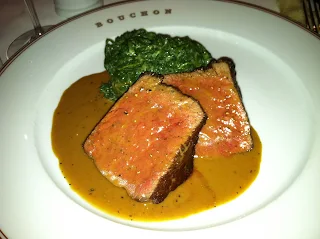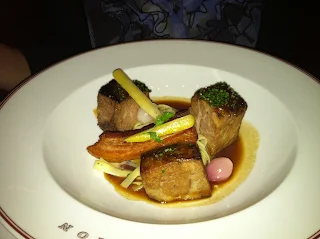This week’s topics include another proud moment for the Wannabe Foodie, how to avoid winning a Darwin award, instructions on safely frying turkeys (i.e., how to embrace your inner hillbilly), and scratch-made pork chile verde from the WF.
The Apple Doesn’t Fall Far from the Tree. Recently, Thing 1 had a birthday. In my house, I make the birthday dinners. So, I ask Thing 1 what he wants for his birthday dinner. “King crab legs.” Uhh… ok. I point out that I may not be able to get them this time of the year and inquire if he has a backup choice. “Lobster.”
Well, now.
Yes, it was an expensive dinner, but I found the king crab claws and legs and cried a small tear of pride and joy at his choices. Seriously, he’s 12 years old and these are his choices?! I think I’ll keep him.
Here’s how I prepare crab legs. I make a roasted garlic butter. I then cut open the legs and claws with shears and drizzled the butter into them. I then roast them at high heat in the oven. Absolutely divine.
My thoughts on crab legs generally – when they’re caught, they’re quickly boiled in salty water. The legs you get are already cooked. I’ve never understood the idea of boiling them again. In my ever so humble opinion, this makes the meat mushy. My preference is a high and dry heat, such as the oven or the grill. I’m just sayin’….
Deep fried turkey. As promised in my last blog, I am writing about frying turkeys. You know you’re sitting there wanting to poo poo the mere suggestion of frying turkeys. Only Cajuns and hillbillies do such a thing! However, we both know that you want to try one yourself.
First, the back story. I have cooked turkeys just about every way you can. Baked, roasted, smoked, and grilled. I haven’t boiled one, but I can’t imagine that would be good. Then again, you could deep poach one French-style in a rich stock. Perhaps with some saffron and garlic…. You know, that’s not the worst idea I’ve ever had.
 But I digress. A number of years ago, I tried my hand at frying a turkey. Since that time, I’ve probably fried 15-20 turkeys. I will never prepare one another way, unless I’m forced to.
But I digress. A number of years ago, I tried my hand at frying a turkey. Since that time, I’ve probably fried 15-20 turkeys. I will never prepare one another way, unless I’m forced to. I know what you’re thinking. “WF. That’s dangerous. You could burn the house down. I’ve seen it on the news.”
Yes. That’s true. You can start hell’s own fire frying a turkey, if you’re not careful. Plus, there’s a decent chance that you’ll win the annual Darwin award.
Some WF keys to safely turkey frying.
1. Don’t be a dumbass.
2. When in doubt, see number 1.
3. Thaw the bird completely before you fry it. Think about what happens when you drop water into hot oil. Now imagine a 20 pound frozen bird. You don’t want that.
4. Before you even think about cooking, put the turkey in the pot. Fill the pot with water until the turkey is just barely covered. Now take the bird out and measure the level of the water with a ruler or a wooden spoon. That’s the amount of oil you’ll need when you eventually fry.
5. Don’t fry the turkey in your garage or on your wooden deck. Think about oil on fire on a wooden deck or slowly spreading across your garage floor. In reality, this is probably covered by # 1. I fry mine in my driveway or, ideally, in the middle of my back yard where only the grass will burn if something goes wrong.
6. Slowly lower the bird into the hot oil. Don’t drop it in.
7. As an added precaution, I turn the flame off while the bird goes in. Once the bird is safely in the oil, I relight the flame.
8. Keep a fire extinguisher next to your chair while frying. I’ve never had to use it, but I’ve always had one.
9. Monitor the temperature of the oil. I usually drop the bird when it’s about 350 and it immediately drops to close to 300. It will slowly take time to get back to 325-350. You don’t want to go much over 375. You certainly don’t want to let it get close to 400. It could burn the bird and cause a fire hazard.
10. This may be the most important one. Make sure you have enough beer in a cooler next to you to last the hour or so it takes to cook the bird. Do NOT leave the cauldron of oil over an open flame unattended so you can go get another beer.
Enough with the lecture. Suffice it to say that frying a turkey is safe if you’re careful.
So how is fried turkey? It’s nothing short of the best turkey you’ve ever had. Juicy, flavorful, and delicious. Check out the photos. It tastes as good as it looks.
I often brine my turkeys overnight. Before frying, I inject them with a mixture of butter, beer, and Cajun spices. I also rub the bird with Cajun spices and salt, which creates this crisp, salty skin that can best be described as turkey candy.
If you’re going to try your hand at this, feel free to drop me a line or post a comment. I’ll send some other hints for making a tasty bird. I don’t to give all of my secrets to everybody!
What Else Am I Working On? Pork chile verde. Here’s the basic ‘recipe’.
I make a sauce of roasted tomatillos, pablano peppers, garlic, white onions, Mexican oregano, and thyme. It takes some time to make your own sauce, but it’s worth it.
I cut up some boneless pork shoulder, season it with a little salt and pepper, and sear the cubes in my French oven. I cover the pork with the yummy sauce and let it simmer for about 3 hours or until the pork is tender. As everything is coming together, I slowly season it to taste. Remember my rant about salt? This dish is scratch-made, so there’s no salt unless I put it in and it needs some salt and pepper.
I served mine with a sort of Mexican rice pilaf I made up, some black beans, a fresh salad, and … wait for it… homemade corn tortillas. Yes, homemade tortillas. It’s embarrassing how easy they are to make!
Unfortunately, I didn’t take any pictures, which is not like me. I will do so the next time I make the dish.
Happy cooking and happy holidays.
WF
P.S. I’m cooking a standing rib roast for Christmas dinner. I may have to take some photos and share!



















